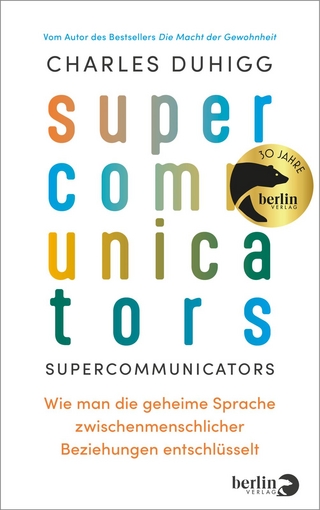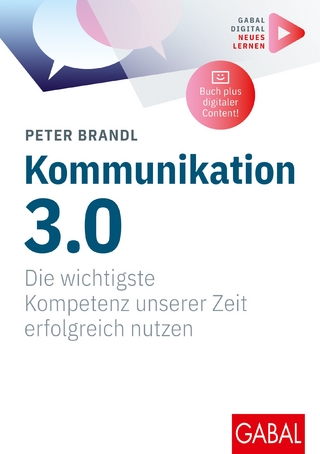
Bridges Not Walls: A Book About Interpersonal Communication
McGraw-Hill Professional (Verlag)
978-0-07-353431-2 (ISBN)
Since the first edition in 1973, Bridges Not Walls has examined the power and promise of interpersonal communication in intimate relationships, families, communities, and cultures. The text presents a broad range of scholarly and popular articles drawn from several disciplines, including communication, psychology, and philosophy, all chosen for their understandability and practical applicability. Within these readings are thought-provoking discussions of interpersonal contact, identity-management, verbal and nonverbal cues, perception, listening, assertiveness and self-disclosure, family communication, intimacy and social support, defensiveness and hurtful communication, conflict management, culture, and dialogue. Together, the readings emphasize the social and relational elements of human communication, the overlapping influence of verbal and nonverbal cues, the prominence of culture, and the close connection between quality of communication and quality of life.
John Stewart is Professor of Speech Communication at the University of Washington and director of the basic interpersonal communication course. His other text is Bridges Not Walls
Part One: FOUNDATIONS OF INTERPERSONAL COMMUNICATIONChapter 1 Introduction to the Editor and to This BookChapter 2 Communication and Interpersonal CommunicationJohn Stewart: Communicating and Interpersonal CommunicatingMalcolm Parks: Personal Relationships and HealthSusan Scott: Fierce ConversationsAbdul K. Sinno, Rafic Sinno, and John Stewart: Social Media: Where Interpersonal Communication Meets Mass CommunicationChapter 3 Communication Building IdentitiesJohn Stewart, Karen E. Zediker, and Saskia Witteborn: Constructing IdentitiesSteve Duck and David T. McMahan: Self and Identity: Transacting a Self in Interaction with OthersDouglas Stone, Bruce Patton, and Sheila Heen: Identity and Difficult ConversationsChapter 4 Verbal and Nonverbal ContactJohn Stewart and Carole Logan: Verbal and Nonverbal Dimensions of TalkSteve Duck and David T. McMahan: Talk and Interpersonal RelationshipsJohn Stewart: Two of the Most Important WordsBen Finzel: Say What? Eight Words and Phrases to Avoid in LGBT CommunicationSteve Duck and David T. McMahan: What Are the Functions of Nonverbal Communication?Part Two: MAKING MEANING TOGETHERChapter 5 Inhaling: Perceiving and ListeningJohn Stewart, Karen E. Zediker, and Saskia Witteborn: Inhaling: PerceptionJulia T. Wood: Its Only Skin Deep: Stereotyping and Totalizing OthersRebecca Z. Shafir: Mindful ListeningJohn Stewart, Karen E. Zediker, and Saskia Witteborn: Empathic and Dialogic ListeningChapter 6 Exhaling: Expressing and DisclosingDavid W. Johnson: Being Open with and to Other PeopleDouglas Stone, Bruce Patton and Sheila Heen: Expression: Speak for Yourself with Clarity and PowerPart Three: RELATIONSHIPSChapter 7 Communicating with Family and FriendsJulia T. Wood: What's a Family, Anyway?Deborah Tannen: Separating Messages from Metamessages in Family TalkSteve Duck: Our Friends, OurselvesWilliam Paul Young: Relationships and PowerChapter 8 Communicating with Intimate PartnersLaura K. Guerrero, Peter A. Andersen, and Walid A. Afifi, Communicating Closeness: Intimacy, Affection, and Social SupportMalcolm R. Parks: Gender and Ethnic Similarities and Differences in Relational DevelopmentLawrence A. Kurdek: What Do We Know About Gay and Lesbian Couples?Erik Qualman: Word of Mouth Goes World of MouthPart Four: BRIDGES NOT WALLSChapter 9 Coping with Communication WallsJohn Stewart, Karen E. Zediker, and Saskia Witteborn: Deception, Betrayal, and AggressionAnita L. Vangelisti: Messages That HurtJack R. Gibb: Defensive CommunicationWilliam W. Wilmot and Joyce L. Hocker: Power: The Structure of ConflictCharles J. Wigley III: Verbal Aggression Interventions: What Should Be Done?Chapter 10 Conflict: Turning Walls into BridgesJoseph P. Folger, Marshall Scott Poole, and Randall K. Stutman: Conflict and InteractionWilliam W. Wilmot: Communication Spirals, Paradoxes, and ConundrumsSteve Duck: Handling the Break-Up of RelationshipsSusan M. Campbell: I Hear You and I Have a Different PerspectiveHugh and Gayle Prather: How to Resolve Issues UnmemorablyChapter 11 Bridging Cultural DifferencesGeert Hofstede and Gert Jan Hofstede: The Individual and the Collective in SocietyDavid W. Johnson: Building Relationships with Diverse OthersDavid A. Anderson: From Racism to GracismDawn O. Braithwaite and Charles A. Braithwaite: “Which Is My Good Leg?” Cultural Communication of Persons with DisabilitiesKaren E. Zediker and John Stewart: Dialogue's Basic TensionMaggie Herzig and Laura Chasin: Fostering Dialogue Across DividesJonathan Sacks: Turning Enemies into FriendsMartin Buber: Elements of the Interhuman
| Erscheint lt. Verlag | 16.7.2011 |
|---|---|
| Zusatzinfo | 9 Illustrations, unspecified |
| Sprache | englisch |
| Maße | 163 x 231 mm |
| Gewicht | 699 g |
| Themenwelt | Sachbuch/Ratgeber ► Beruf / Finanzen / Recht / Wirtschaft ► Briefe / Präsentation / Rhetorik |
| Geisteswissenschaften ► Psychologie ► Sozialpsychologie | |
| Sozialwissenschaften ► Kommunikation / Medien ► Kommunikationswissenschaft | |
| ISBN-10 | 0-07-353431-5 / 0073534315 |
| ISBN-13 | 978-0-07-353431-2 / 9780073534312 |
| Zustand | Neuware |
| Haben Sie eine Frage zum Produkt? |
aus dem Bereich


